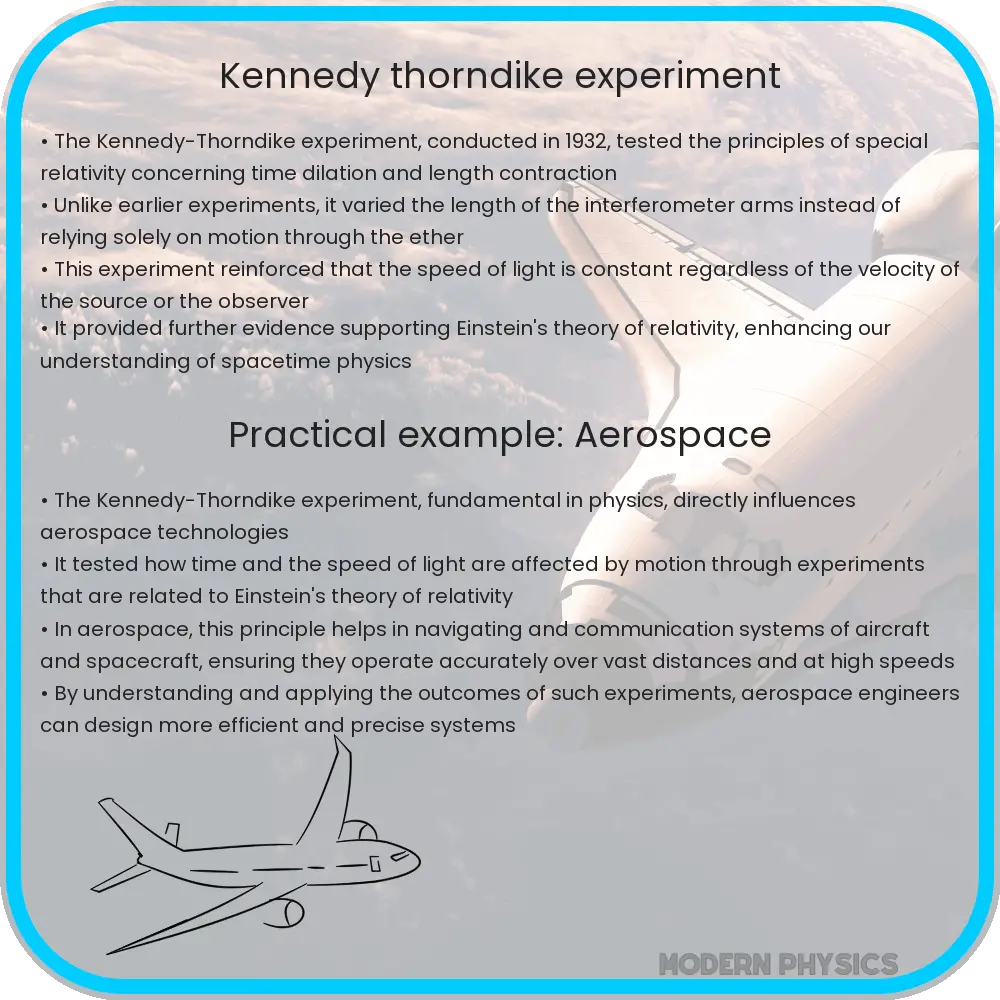Explore the Kennedy-Thorndike Experiment’s role in validating time dilation, length contraction, and Lorentz transformations in physics.

Kennedy-Thorndike Experiment: Unveiling the Mysteries of Time Dilation and Length Contraction
The Kennedy-Thorndike Experiment, conducted by Roy J. Kennedy and Edward M. Thorndike in 1932, is a crucial cornerstone in the field of physics, particularly in understanding the principles of time dilation and length contraction as postulated by Albert Einstein’s theory of Special Relativity. This landmark experiment not only corroborated the Lorentz transformations but also profoundly influenced our perception of space and time.
Understanding Time Dilation and Length Contraction
Time dilation and length contraction are fascinating yet counterintuitive concepts in physics. Time dilation refers to the phenomenon where time appears to pass slower for an object in motion compared to a stationary observer. This effect becomes more pronounced as the object approaches the speed of light. Length contraction, on the other hand, suggests that objects in motion contract along the direction of their motion as observed from a stationary frame of reference.
These phenomena are governed by the Lorentz transformations, mathematical formulas that relate the space and time coordinates of two observers moving at a constant velocity relative to each other. The equations are given by:
- \(x’ = \gamma (x – vt)\)
- \(t’ = \gamma (t – \frac{vx}{c^{2}})\)
where \(x\) and \(t\) are the position and time coordinates in the stationary frame, \(x’\) and \(t’\) are the coordinates in the moving frame, \(v\) is the relative velocity, \(c\) is the speed of light, and \(\gamma\) is the Lorentz factor defined as \(\gamma = \frac{1}{\sqrt{1 – \frac{v^{2}}{c^{2}}}}\).
The Kennedy-Thorndike Experiment
The experiment by Kennedy and Thorndike was designed to test the predictions of Special Relativity regarding time dilation and length contraction. They used an optical interferometer, a device that splits a beam of light into two paths, allowing one beam to travel in the direction of the Earth’s motion and the other perpendicular to it. The idea was to detect any changes in the interference pattern of light beams caused by the Earth’s motion through space, which would indicate time dilation and length contraction effects as predicted by Lorentz transformations.
The genius of the Kennedy-Thorndike Experiment lies in its simplicity and precision. It elegantly demonstrated that the speed of light is constant in all inertial frames of reference, a fundamental postulate of Einstein’s theory. This experiment, along with the Michelson-Morley Experiment and the Ives-Stilwell Experiment, forms the empirical basis for the theory of Special Relativity, profoundly shaping our understanding of the universe.
Implications and Results of the Kennedy-Thorndike Experiment
The results of the Kennedy-Thorndike Experiment were groundbreaking. The experiment confirmed that time dilation and length contraction indeed occur as predicted by the Lorentz transformations. The precision of their measurements was such that any variations due to the Earth’s motion through the aether, if it existed, would have been detected. However, no significant differences were observed in the interference patterns, thereby reinforcing the postulate that the speed of light is constant in all inertial frames.
This experiment played a pivotal role in discrediting the luminiferous aether theory, which posited a medium through which light waves propagated. The absence of any detectable aether wind in the Kennedy-Thorndike Experiment, along with the earlier Michelson-Morley Experiment, provided substantial evidence against this theory.
Modern Applications and Continuing Significance
The principles verified by the Kennedy-Thorndike Experiment have far-reaching implications beyond theoretical physics. They are fundamental to modern technologies such as the Global Positioning System (GPS), which relies on precise time measurements. The time dilation effects, as predicted by Special Relativity, must be accounted for in GPS satellites to ensure accuracy. This is a testament to the practical relevance of the experiment’s findings in our daily lives.
Furthermore, the experiment’s confirmation of Special Relativity has paved the way for further exploration in physics, including the development of General Relativity and quantum field theory. It continues to inspire contemporary research in cosmology and particle physics, contributing to our understanding of the universe from the smallest particles to the vastness of cosmic phenomena.
Conclusion
In conclusion, the Kennedy-Thorndike Experiment stands as a monumental achievement in physics. By empirically validating the predictions of time dilation and length contraction under Special Relativity, it not only reshaped our understanding of space and time but also laid the groundwork for modern physics and technology. The experiment’s elegant design and conclusive results are a testament to the enduring power of scientific inquiry and experimentation. It continues to inspire and inform physicists, engineers, and scholars, underscoring the profound impact that theoretical concepts can have when brought to the test in the physical world.
